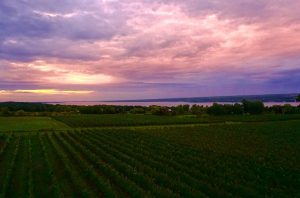Of all the Empire State’s American Viticultural Areas (AVAs), perhaps none shine brighter than the Finger Lakes AVA. The state is a viticultural beacon on the country’s eastern seaboard: ‘American wine’ is often taken as code for California or the West Coast, but New York is the third-largest-producing state by volume.
Stretching from the eastern reaches of Long Island to the western shores of Lake Erie, New York is a diverse state both geographically and viticulturally. Its cool climate is one of the consistent elements of New York’s wine scene, but in its idiosyncrasies, this world-class wine region offers something for everyone.
Formation of the Fingers
In comparison to the Great Lakes, which reach from the west of New York state into America’s upper Midwest, the Finger Lakes sound almost dainty – but their formation was a result of dramatic Ice Age geological shifts. Geological records indicate that the Finger Lakes were formed more than two million years ago: as glaciers crept through the area, they carved deep slices into the land. Eventually, the ice melted, and these deep gouges were filled with water.

Credit: Rima Brindamour
From west to east, the 11 lakes are Conesus, Hemlock, Canadice, Honeoye, Canandaigua, Keuka, Seneca, Cayuga, Owasco, Skaneateles and Otisco. Wine growing centres around the larger lakes in the centre: Canandaigua, Keuka, Seneca and Cayuga. Their substantial size (Seneca Lake, for example, reaches a staggering 188 metres at its deepest point) creates moderating conditions that make their shores perfectly suited to viticulture.
A reputation for Riesling
As trendy as US Riesling is today, it is far from a modern phenomenon – in fact, plenty of Riesling was being made in the US before Prohibition. Introduced by German immigrants in the latter part of the 19th century, it was once even the dominant white variety in Napa Valley.
Riesling excels in colder climates due to its physiology: the vines are hard-wooded, making them very cold-tolerant, and they bud late, meaning they are less susceptible to frosts and early-season cold snaps. All this means that in New York, Riesling has found a brilliant match.

1958 was a pivotal moment in New York’s wine history: Dr Konstantin Frank, a Ukrainian immigrant with a PhD in cool-climate viticultural techniques – and experience growing Vitis vinifera in his native country, where temperatures regularly fall below zero – planted Riesling on the western shore of New York’s Keuka Lake. This marked the beginning of a new era for New York’s wine industry.
His vision would become the foundation for New York’s fine wine production, particularly the Finger Lakes’ modern reputation for producing world-class Riesling. It is now the most planted vinifera grape in the state, and the one for which New York has gained a particular reputation.
The cool-climate kids
Riesling’s roots run deep in the Finger Lakes region, and five top examples were singled out for praise in Decanter‘s May issue. Indeed, the variety’s popularity with sommeliers and chefs has meant that a Riesling renewal has flooded the region with a steady stream of fresh creative talents. Acclaimed winemakers like Nathan Kendall, Julia Hoyle and Kelby James Russell lead a new generation of New York’s vibrant wine scene. With deep experience and a keen sense of local pride, they’re crafting wines worthy of international acclaim.
‘I lean into the beauty we have here: higher acid, lower alcohol; more delicate wines in general,’ says Kendall. The Finger Lakes native has worked at wineries in New Zealand, Sonoma, Australia and Germany’s Mosel Valley. While the region makes refined and elegant wines, its relatively short viticultural history makes it an exciting, liberating environment in which to create wine – a blank slate. ‘It’s kind of the Wild West here,’ he explains, ‘Between red, white and sparkling, plus Vitis vinifera, hybrid and Vitis labrusca, it’s really anything goes.’

Credit: Rima Brindamour
Like Kendall, Christopher Bates came home to New York after making wines in Germany, founding Element Winery in the Finger Lakes in 2009; he is excited about the present and the region’s still ‘largely unrealised potential.’
So what does the future hold for the Finger Lakes? Like so many others, Bates is confident in the region and its lively viticultural community as one well positioned for growing and making wine in a changing climate – and above all, is glad to have returned to the stunning region. ‘When I was elsewhere, I kept finding myself more and more enamoured with the natural beauty of the Finger Lakes.’
Discover more about New York Wines
Connect on
Facebook | Instagram | LinkedIn | X








